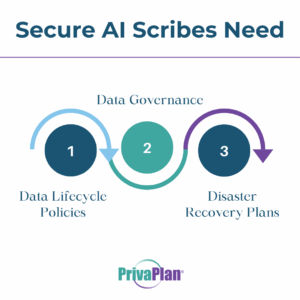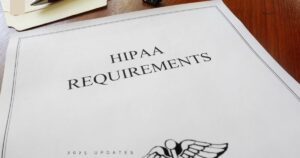Discover the Role of AI Ambient Scribes in Medical Documentation
Learn how AI Ambient Scribes are transforming health care documentation. Learn what they are, their benefits, and how your clinic can prepare for a seamless and successful integration.
In This Post
What are AI Ambient Scribes?
Artificial Intelligent (AI) Ambient Scribes are a keen digital health solution remaking health care workflows. These AI tools are designed to listen during patient encounters (in-person or virtual), automatically capture comprehensive clinical notes, and summarize them into the electronic health record (EHR) format.
Some AI Ambient Scribes work in real-time, transcribing and organizing information as the conversation unfolds. Others pull audio recordings and transcribe key details afterward. In both cases, clinicians review the notes and make adjustments before adding the documentation to the patient’s health record.
All AI Ambient Scribes utilize automated speech recognition and large language models (LLMs) to convert audio into text. They are trained in medical knowledge, enabling them to recognize nuances in speech patterns and medical terminology. This includes the crucial ability to distinguish between a “murmur of reassurance” and a “cardiac murmur.”
The Benefits of AI Ambient Scribes for Health Care Providers
AI Ambient Scribes are most noteworthy because they can improve the quality of patient-provider relationships during a patient encounter and the quality of documentation. Most importantly, in today’s demanding health care environment, AI Ambient Scribes have the potential to reduce clinician burnout by reducing the time spent on documentation during and after work.
The report from the Peterson Health Technology Institute (PHTI), titled “Adoption of Artificial Intelligence in Healthcare Delivery Systems: Early Applications and Impacts,” highlights that for every hour a clinician spends with a patient, they spend an additional two hours on documentation in the EHR. Furthermore, one in five clinicians report spending eight or more extra hours per week working in the EHR.
The PHTI report also noted that patient interaction improved when clinicians used AI Ambient Scribes during appointments. Relying on the AI Scribe for transcription notes allowed clinicians to engage directly; they could spend more time making eye contact, actively listening, and participating in meaningful conversation with patients instead of focusing on a computer screen.
As a result, AI Ambient Scribes are becoming an increasingly attractive solution for health care organizations looking to balance high-quality patient care with the demands of clinician administrative responsibilities.
AI Ambient Scribes offer the following benefits:
- Time saved
- Reduced administrative overload
- Improved accuracy of patient encounter notes
- Enhanced patient-provider interactions
AI Ambient Scribes and Data Privacy

While an AI Scribe can elevate the clinician’s experience, it must also be able to balance the crucial need for data privacy to ensure regulatory compliance and maintain patient trust.
Integrating an AI Scribe into clinic workflows requires configuring security settings to comply with the HIPAA Security Rule, ensuring that electronically protected health information (ePHI) remains private.
Security elements include items such as:
- Access controls
- Transmission and encryption security
- Data governance policies and procedures
- Data integrity and management
- Logging, monitoring and incident reporting
When selecting an AI Scribe solution to integrate into your clinic’s workflow, it’s essential to develop comprehensive policies and procedures for data management. This includes clearly defined methods for collecting data and what types of information will be gathered during the clinical process.
By prioritizing these elements, you can ensure that your AI Scribe solution supports not only efficiency in clinical workflows but also the integrity and security of patient information.
From Compliance to Accuracy: AI Ambient Scribes Meet HIPAA Security Rule
To successfully implement an effective AI Scribe workflow process, you must understand the clinical and administrative workflows across the entire organization. This includes examining the data governance, metadata, documentation practices, and how different departments communicate and collaborate.
By gaining this insight, you can tailor the AI scribe system to seamlessly integrate into existing processes, enhance efficiency, and improve the overall inputs and outcomes of the AI Scribe transcriptions.
But getting started in the process of integrating an AI tool and retaining HIPAA compliance can be confusing. That’s where our new guide comes in!
Prepare Your Clinic for a Seamless AI Ambient Scribe Integration with PrivaPlan’s Essential Guide
Our Third-Party Generative AI in Health Care: Balancing Innovation with the HIPAA Security Rule guide draws on our 20 years of HIPAA compliance expertise to help health care organizations confidently adopt generative AI solutions with a proactive approach to protect the confidentiality, integrity, and availability of sensitive health data.
This practical guide bridges the gap between HIPAA and AI by providing frameworks and actionable strategies for implementing AI tools that align with the HIPAA Security Rule and the National Institute of Standards and Technology (NIST) framework.
The guide includes how to:
- Map out AI governance
- Configure concentrated HIPAA focused security settings
- Establish clear policies for input and output
- Ensure data privacy
- Provide training and support for your workforce
Boosting the AI Scribe security settings isn’t just about meeting regulatory standards; it’s a step toward building trust and credibility among your workforce and patients.
Don’t miss out on the chance to improve your health clinic workflow and grab your copy today!
The Essential Guide for Ensuring HIPAA Compliance in Generative AI Systems
Download your copy now and take the first steps towards integrating generative AI tools with clarity!




